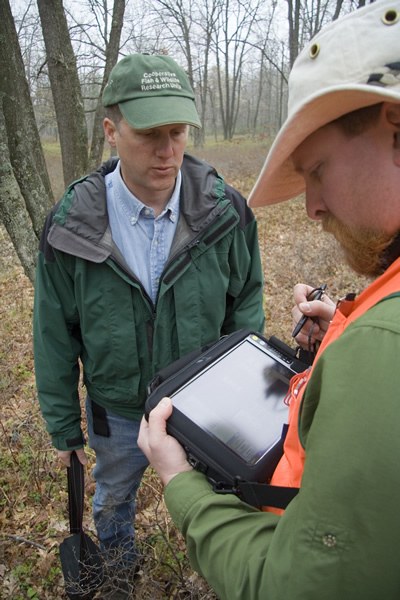Regardless of the cause of the shift in forest composition, these transitions affect the wildlife populations that are dependent on these habitat settings.

Dr, Duane Diefenbach, instructs student on use hand-held computer units; Photo by Gordon Harkins
Oaks and hickories supply many small mammals and birds with nuts and acorns. And the oak's rough bark--unlike the maple's smooth bark--houses bark-dwelling insects for insect-eating birds. The previously mentioned proliferation of red maple creates allied biodiversity concerns.
Dr. Margaret Brittingham, professor of wildlife resources, has evaluated the effects of forest loss on wildlife in terms of fragmentation of contiguous environments into smaller and less effective parcels. Various songbirds have lost significant breeding grounds through this attrition process. Seasonal migration routes may not provide the abundance of food that certain species rely upon in their fall and spring movements.
Dr. Margaret Brittingham and Dr. John Carlson, associate professor of molecular genetics, have found that a growing scarcity of black ducks is not due to habitat problems in northern nesting grounds, but rather to cross breeding with mallards. Since 1940 or so, hybridization of black ducks and mallards has resulted in fewer black ducks. The researchers conducted DNA tests on duck wings obtained from the Atlantic Flyway counts done by the U.S. Fish and Wildlife Service. The testing indicated that historically mallards and black ducks were very different genetically, and have become much more similar in recent decades due to hybridization. "Because the mallard population is so much bigger to begin with, the effect is greatest on the black-duck population," explains Dr. Brittingham. In looking at the DNA of modern specimens, black ducks are no longer very distinct from mallards, and we are losing the unique species known as the black duck.
Dr. Chris Goguen, senior lecturer, recognizes a certain advantage in having a diversity of habitat types outside of forests to encourage the variety of songbird species found in our eastern states. In particular, open grasslands that follow strip mining have proven to be a major asset for various sparrows and other ground-nesting species. Similar benefits have been identified for large mammals, including Pennsylvania's unique elk herd, now numbering near 800 animals.
Dr. Walter Tzilkowski, associate professor of wildlife science, in conjunction with Dr. Charles Strauss, professor of forest economics, and Dr. Bruce Lord, senior research assistant, evaluated the increasing size of this elk herd and its ramifications for tourism within northcentral Pennsylvania. The combination of forests and grassland complimented herd growth but the pressures of added tourists on small communities introduced new social problems. Accordingly, the herd size was stabilized through special hunting seasons monitored by the Pennsylvania Game Commission.
Decades of selective browsing by an overpopulation of white-tailed deer has caused an increase in species such as hay-scented ferns, which compete successfully with tree seedlings, according to Dr. Gary San Julian, professor of wildlife resources. He believes it is clear that where deer are most numerous, seedlings are devoured before they can grow out of reach of voracious whitetails.
However, Dr. San Julian concedes it is likely that several factors are contributing to the change in forest composition in Pennsylvania. "It may be that decades of fire suppression, acid rain, and deer damage have all combined to create an environment that is not favorable to red oaks and a few other desirable tree species."
Measuring deer impacts on relatively small blocks of forestland is not a new concept, with scientists repeatedly making intensive measurements of tree regeneration. But developing an accurate, cost-effective technique for using these measures across a broad scale to help make management decisions for hundreds of square miles of forest is new. Dr. Duane Diefenbach, adjunct associate professor of wildlife and associate unit leader of the Pennsylvania Cooperative Fish and Wildlife Research Unit, is working on that.
Dr. Diefenbach, his colleagues in the School, and his most dependable students walked transects--with the aid of geographic system technology--and counted plants. They tallied wildflowers that deer prefer, such as Canada mayflower, jack in the pulpit, Indian cucumber, and trillium. "Even if you don't believe over-browsing is an issue in Pennsylvania forests," Dr. Diefenbach elaborates, "at least we are starting to look beyond deer numbers and trying to find ways to assess habitat conditions as they are most relevant to deer."

